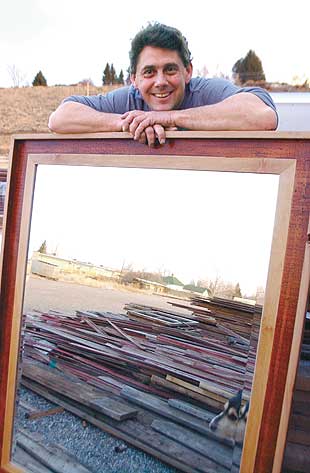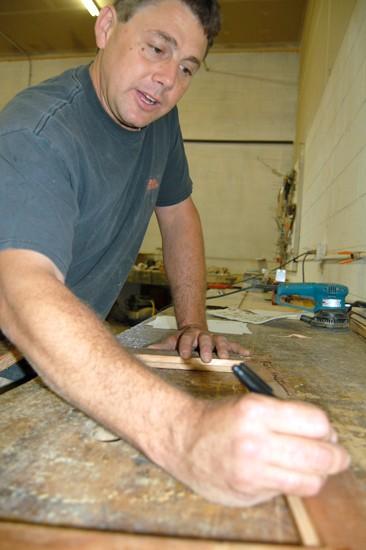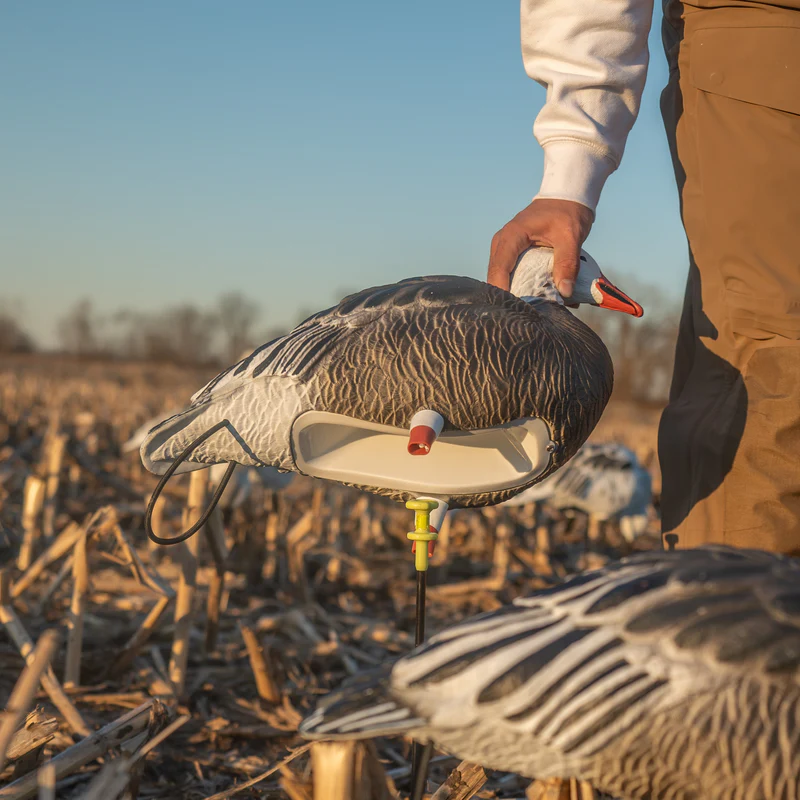On the Monday afternoon Carbon County flooded, Rich Holstein was laid up in a hospital bed. He’d had a toe amputated a few weeks prior and an infection landed him back for treatment with intravenous antibiotics.
“I was getting phone calls, and I live damn near a half-mile from the river. There should not be water here,” Holstein said of friends buzzing his phone as he was tethered by IV tubing, miles from home and unable to monitor the situation first-hand.
Then he saw his boat on the 5:30 p.m. newscast, floating on its trailer in front of his home.
“By the time I got out there, all I could do was cry looking around at everything. It was just devastation,” Holstein said. “You wouldn’t think … I’m 3/8th of a mile from the river. I’m in the middle of town, in a mobile home, and I’m still flooded.”
Had he been home in Fromberg, Holstein still couldn’t have saved from the rapidly rising water all the wood he salvaged years ago from the Old Faithful Inn in Yellowstone. It was the material he used to build photo frames and a successful business in selling them. The river came for his livelihood too fast and in the middle of the night.
People are also reading…

Aileen Rogers helps clean out a friend’s house badly damaged by the severe flooding in Fromberg.
Holstein does figure he could have collected some clothing and at a minimum his vehicle. But when he finally got out of the hospital around 11 a.m. Tuesday, the scene that met him as home was something he described as “all hell broken loose.”
“I’d seen pictures of my Navigator (vehicle). It had floated about 10 feet away. And my camper’s flooded,” Holstein said.
Because of his health issues — 22 surgeries in the last four years — Holstein tried to “save every penny I could” for paying down medical debt. That included dropping comprehensive coverage on his vehicle, meaning the flood left it a total loss.
And as far too many people in Montana have learned over the last few weeks, homeowners insurance doesn’t do a thing in the case of a flood.
“My car’s gone. My backup plan is my camper, but the camper had 2 ½ feet of water in it,” Holstein said.
Lack of coverage
Early estimates pegged the loss across Carbon, Park and Stillwater counties at about 115 residences fully or mostly destroyed. The state Commissioner of Securities and Insurance said the number of flood insurance policies in place throughout those communities was dismal.
There were just 18 policies in Red Lodge and 58 in unincorporated Carbon County. Livingston had only nine policies and there were 77 across the rest of Park County. There were 69 policies in Stillwater County, and just two in Columbus.
“They’re just horrible numbers,” Troy Downing said.
Flood insurance is expensive, Downing said, and something few people get unless their lender requires it. And even in those cases, the insurance can sometimes cover only what the lender worries about — the home they put up the money for — and not its contents or what happens to the people who lived there.
“If it’s lender-placed, the lender cares about protecting their interest in the mortgage,” Downing said. “They don’t care about protecting your content or anything else. A lot of that is inadequate.”
Most people in Montana who have flood insurance have coverage through the National Flood Insurance Program, which offers coverage in 23,000 communities around the nation in the floodplain that participate. There are also sometimes private insurance options.
As he traveled around the region meeting with people who lost homes and belongings, Downing said the most common reason he heard for people not purchasing insurance is that it’s too expensive.
In some rare cases, a flood policy can double the cost of regular home insurance, but Downing said more commonly getting coverage for a flood means a 50% to 90% increase in home insurance costs.
Renters are also in a similar position to homeowners — unless they have a specifically purchased policy, they are likely without any coverage.
Downing said it was heartbreaking to meet so many people who were “painfully uninsured.”
“There’s not a whole lot we can do other than listen and try to direct people to resources that are out there,” Downing said.
As cleanup efforts started, Downing encouraged those with damage to document everything, even those without insurance. That was because of the hope that the Federal Emergency Management Agency would get involved.
FEMA aid
On June 23, Gov. Greg Gianforte requested FEMA activate the Individual Assistance program under the presidential major disaster declaration, citing in part a lack of flood insurance for many who lost homes and belongings.

Montana Gov. Greg Gianforte tours flooded agricultural land with county commissioner Scott Miller, left, and rancher Jay Stetson, right, near Fromberg on June 21.
“While some survivors have insurance policies, many are at risk for being underinsured and/or not having the correct peril for coverage,” the request read. “The sudden impact of the severe flooding resulted in significant loss of many homes and personal property contained therein.”
On Thursday, FEMA said it approved Montana’s request.
“I appreciate Administrator Deanne Criswell and her team at FEMA for working with us to fast track Individual Assistance for Montanans impacted by the flooding disaster,” Gianforte said in a press release. “These funds will help Montanans get back on their feet as they rebuild and recover in the weeks and months ahead.”
People in Park, Stillwater and Carbon counties who have losses from flooding can now file a claim with their insurance company and apply for FEMA assistance at floodrecovery.mt.gov.
FEMA’s program for individuals and households includes financial and direct services intended to meet basic needs and supplement disaster recovery efforts. The FEMA website warns “assistance is not a substitute for insurance and cannot compensate for all losses caused by a disaster.”
The assistance can help cover things like temporary housing through rental aid or paying for hotel costs, temporary housing units, money to repair or replace primary residence and access like driveways or roads, cash to help replace uninsured or under-insured losses such as personal property and vehicles, and more.
Downing said as he sees the images of destruction come from the Yellowstone region, he is thinking ahead of how to encourage people to buy flood insurance for the future. He pointed to Miles City, which was partly submerged with massive floods in 2018. Now there are 718 residences with flood insurance policies in town.
“A lot of it is just memory,” Downing said. “If people bite the bullet and purchase those policies, it’s because they’ve seen what can happen.”
Lots of loss
Holstein, who has worked as an artist in the Yellowstone region for more than 20 years, was planning a career change because of his health. The flood unexpectedly forced him to accelerate that timeline.
Plug Holstein’s former address where he lived and worked into the FEMA floodplain map and it shows he’s on the far edge of an area that has a 0.2% annual chance of a flood hazard. Just a few structures away he’d be out of any sort of flood zone entirely.
Water submerging part of his home was the last thing he thought possible.
“Emotionally, I will tell you, I sat on a park bench I built 25 years ago that survived the flood. I pulled it out of the mud,” Holstein said in an interview last week. “After Katrina, you see people sitting on the bench, on their stoop or something, and they just look blank. I never understood that. And that was just me now. You don’t know where to start.”
Getting into his house after the waters receded was “death-defying,” Holstein said. “I didn’t lose as hard inside the house as some did. I didn’t lose everything, but I lost enough.”
The saddest part, Holstein said, was when flood waters carried away the original wood flooring he reclaimed from the Old Faithful Inn. During the 100-year restoration of the hotel in Yellowstone, he spent four winters working for free to save the material from the landfill. Now it’s all gone.

Rich Holstein, seen in this 2006 file photo, made custom mirrors and picture frames using wood reclaimed from old buildings.
“I can’t sell Old Faithful Inn picture frames anymore,” Holstein said. “I lost my business.”
Holstein estimates the wood that was left would have lasted another two to five years. He was also saving some for family and friends. He’s made nearly 30,000 frames from the Old Faithful flooring, he said.

Rich Holstein hand signs and individually numbers the last of the 110 mirror frames he is donating to Yellowstone National Park’s Old Faithful Inn, as seen in this 2006 file photo.
“It’s all gone. It ended just like that,” Holstein said. “It was going to end anyway, because of me physically, but it’s not on my own terms. It’s on Mother Nature’s terms.”
An area that can’t take hard hits
Montana’s application to FEMA for individual assistance was peppered with statistics noting the financial challenges facing those who live in Park, Stillwater and Carbon counties.
The population is on the whole older than the rest of the state, meaning incomes are likely fixed. The number of those age 65 and up is 22.5% in Park County, 25.6% in Carbon and nearly 23% in Stillwater, compared to the statewide average of 18.7%
The price tag for a monthly mortgage is nearly 38% of the average household’s income in Park County and rent is about a third of income across the affected area. Home prices have soared in the region and housing is hard to find. There is also a higher percentage of people living in mobile homes in the three counties than the rest of the state and country.
“Mobile home residents have been shown to be disproportionately impacted by disasters — due to physical characteristics of the home, location, social vulnerabilities of residences and complicated ownership agreements,” Montana’s request for federal aid said.
Two years ago, Holstein lost his house because of medical bills and moved into a mobile home to downsize and reduce expenses. He fixed it up with a new gas mainline.
When Holstein got out of the hospital and came back to a flooded residence, he saw what kept the back half of the home from falling fully into the water was that gas line — acting like an anchor.
With his home uninhabitable, Holstein is staying with his girlfriend, though space is tight.
On a trip to the hospital after seeing the flood damage at his home, a case manager offered Holstein a popup trailer. It was an incredible gesture, but still doesn’t fix his housing problem.
“You’re left speechless,” Holstein said. “That’s not coming from the hospital. It’s coming from a person who just happened to come in and be working with me. A popup trailer gives me a place to go for a night, but I got nothing to tow it with, I gotta find a place to put it. That hasn’t been solved yet.”
With a lot of his town in a similar position, Holstein is worried people might just leave.
“There’s already no housing in this area,” Holstein said. “ … There’s maybe four to five rentals coming open in the last year. There’s nowhere for anybody to go. You can’t find a house. … All of us that live out in the country love our little community. I leave my keys in the car and house unlocked. It’s not the same.”
Aside from trying to find a place to live, there’s the cost of going back and forth between Fromberg and Billings to where Holstein found storage units for the few belongings he salvaged. He’s getting rides, but wants to pay for the gas. A local group is offering $25 and $50 gift cards, but that barely covers the gas for a trip and a half.
His side of town, Holstein said, was a low-income area.
“You’re talking about people in Section 8, fixed incomes, single moms. It’s not just me. It’ll get through it. I’ll survive. Mentally I’m starting to get a little more past the initial shock, but hell, it’s taken over a week just to get past the initial shock,” Holstein said. “It’s not a place that can take this kind of hit. Everybody has a story, everybody is going through their own situation.”
What’s next
In the days immediately after the flood, FEMA was largely absent, Holstein said.
“I’m on a wing and a prayer. They said save all your receipts,” Holstein said. He’s started a Go Fund Me to help offset his costs.

Harley Holmes, 8, cleans out her room as her family is forced to leave their home left damaged by severe flooding in Fromberg on June 17.
Still, Holstein’s optimism kept showing up in an interview, even as he spoke with friends about where he needed help with a Bobcat someone had brought in to clear debris. Through his career, Holstein said he’s donated about $414,000 to charities, and now the thing he’s best able to give is sharing the mantra he’s lived by for the last 25 years — “learn from yesterday, live for today, hope for tomorrow.”
He’s reaching out to neighbors he sees walking around, showing the outward signs of defeat in slumped shoulders and hanging heads.
“If you tell yourself you don’t know how you’re going to get through it or you don’t know how it’s going to happen or you’re talking negative to yourself, it’s going to knock you down,” Holstein said. “I’m still keeping a good attitude and always smiling. What the hell else am I going to do? If I don’t laugh at it, I’m going to break down and cry.”
Holly Michels is the head of the Montana State News Bureau. You can reach her at [email protected]























